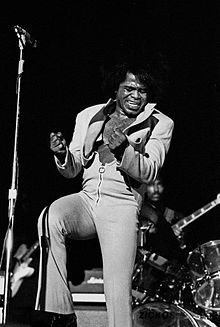
Back James Brown Afrikaans James Brown ALS ጄምስ ብራውን Amharic James Brown AN جيمس براون Arabic جيمس براون ARZ James Brown AST Ceyms Braun Azerbaijani جیمز براون AZB Джэймс Браўн Byelorussian
James Brown | |
|---|---|
 Brown in 1973 | |
| Born | James Joseph Brown May 3, 1933 Barnwell, South Carolina, U.S. |
| Died | December 25, 2006 (aged 73) Atlanta, Georgia, U.S. |
| Occupations |
|
| Years active | 1953–2006 |
| Spouses | Velma Warren
(m. 1953; div. 1969)Deidre Jenkins
(m. 1970; div. 1981)Adrienne Rodriguez
(m. 1984; died 1996) |
| Partner | Tomi Rae Hynie (1997–2006) |
| Children | 9–13 |
| Musical career | |
| Origin | Toccoa, Georgia, U.S. |
| Genres | |
| Instruments |
|
| Discography | James Brown discography |
| Labels | |
| Formerly of | |
| Website | jamesbrown |
James Joseph Brown (May 3, 1933 – December 25, 2006) was an American singer, dancer, and musician. The central progenitor of funk music and a major figure of 20th-century music, he is referred to by various nicknames, among them "Mr. Dynamite", "the Hardest-Working Man in Show Business", "Minister of New Super Heavy Funk", "Godfather of Soul", "King of Soul", and "Soul Brother No. 1".[1] In a career that lasted more than 50 years, he influenced the development of several music genres.[2] Brown was one of the first ten inductees into the Rock and Roll Hall of Fame on January 23, 1986. His music has been heavily sampled by hip-hop musicians and other artists.[3]
Brown began his career as a gospel singer in Toccoa, Georgia.[4] He rose to prominence in the mid-1950s as the lead singer of the Famous Flames, a rhythm and blues vocal group founded by Bobby Byrd.[5][6] With the hit ballads "Please, Please, Please" and "Try Me", Brown built a reputation as a dynamic live performer with the Famous Flames and his backing band, sometimes known as the James Brown Band or the James Brown Orchestra. His success peaked in the 1960s with the live album Live at the Apollo and hit singles such as "Papa's Got a Brand New Bag", "I Got You (I Feel Good)" and "It's a Man's Man's Man's World".
During the late 1960s, Brown moved from a continuum of blues and gospel-based forms and styles to a new approach to music-making, emphasizing stripped-down interlocking rhythms that influenced the development of funk music.[7] By the early 1970s, Brown had fully established the funk sound after the formation of the J.B.s with records such as "Get Up (I Feel Like Being a) Sex Machine" and "The Payback". He also became noted for songs of social commentary, including the 1968 hit "Say It Loud – I'm Black and I'm Proud". Brown continued to perform and record until his death from pneumonia in 2006.
Brown recorded and released 17 singles that reached No. 1 on the Billboard R&B charts.[8][9] He also holds the record for the most singles listed on the Billboard Hot 100 chart that did not reach No. 1.[10][11] Brown was posthumously inducted into the first class of the Rhythm & Blues Music Hall of Fame in 2013 as an artist and then in 2017 as a songwriter. He received honors from several other institutions, including inductions into the Black Music & Entertainment Walk of Fame[12] and the Songwriters Hall of Fame.[13] In Joel Whitburn's analysis of the Billboard R&B charts from 1942 to 2010, Brown is ranked No. 1 in the Top 500 Artists.[14] He is ranked seventh on Rolling Stone's list of the 100 Greatest Artists of All Time,[15] and at No. 44 on their list of the 200 Greatest Singers of All Time.
- ^ Doran, John (October 28, 2015). "James Brown – 10 of the Best". The Guardian. Archived from the original on October 31, 2015. Retrieved October 31, 2015.
- ^ Wiegand, D. (December 26, 2006). "James Brown: 1933–2006 – Godfather of Soul Changed Music at Frenetic Pace". San Francisco Chronicle. Archived from the original on May 17, 2012. Retrieved January 10, 2007.
- ^ "James Brown". The Vogue Theatre. Retrieved August 13, 2024.
- ^ Hay, Fred J. (2003). "Music box meets the Toccoa band: the godfather of soul in Appalachia". Black Music Research Journal. 23 (1–2): 103–133. doi:10.2307/3593211. ISSN 0276-3605. JSTOR 3593211. Retrieved January 30, 2020.[permanent dead link]
- ^ "The Famous Flames Biography | The Rock and Roll Hall of Fame and Museum". Rockhall.com. Archived from the original on June 25, 2012. Retrieved February 16, 2013.
- ^ "James Brown Biography | The Rock and Roll Hall of Fame and Museum". Rockhall.com. Archived from the original on April 3, 2013. Retrieved February 16, 2013.
- ^ Collins, W. (January 29, 2002). "James Brown", St. James Encyclopedia of Popular Culture. Retrieved January 12, 2007.
- ^ Corpuz, Kristin (May 3, 2017). "James Brown's Biggest Billboard Hot 100 Hits". Billboard. Archived from the original on April 23, 2021. Retrieved May 9, 2018.
- ^ Whitburn 2010, p. 89.
- ^ Cite error: The named reference
rsfunkwas invoked but never defined (see the help page). - ^ Whitburn, J. (2000). Top Pop Singles: 1955–1999. Menomonee Falls, Wisconsin: Record Research. p. 900. ISBN 0-89820-140-3.
- ^ "Black Music & Entertainment Walk of Fame Announced With First Three Inductees". Billboard. February 18, 2021. Archived from the original on April 16, 2021. Retrieved April 15, 2021.
- ^ "Songwriters Hall of Fame – James Brown Recordings". Archived from the original on June 29, 2011. Retrieved July 19, 2012.
- ^ Whitburn 2010, p. 873.
- ^ "100 Greatest Artists Of All Time. 7. James Brown". Rolling Stone. Archived from the original on September 7, 2018. Retrieved April 11, 2014.